Phosphorous- and Boron-Doped Graphene-Based Nanomaterials for Energy-Related Applications
Abstract
1. Introduction
2. Synthesis Methodologies
2.1. Synthesis of Phosphorous-Doped Graphene Nanosheets (P-GNS)
2.1.1. Direct Methods
2.1.2. Post-Treatment Methods
Thermal Decomposition
Electrochemical Erosion Methods
2.2. Synthesis of Boron-Doped Graphene Nanosheets (B-GNS)
2.2.1. Direct Methods
Chemical Vapour Deposition (CVD) Method
Self-Assembly Method
2.2.2. Post-Treatment Methods
Arc-Discharge Method
Thermal Annealing Method
Wet Chemical and Vacuum Activation Methods
3. Energy Applications
3.1. Applications of P-GNS
3.1.1. Fuel Cells
3.1.2. Lithium-Metal Batteries
3.1.3. Alkaline Ion Batteries
3.1.4. Supercapacitors
3.2. Applications of B-GNS
3.2.1. Fuel Cells
3.2.2. Solar Cells
3.2.3. Lithium-Metal Batteries
3.2.4. Alkaline Ion Batteries
3.2.5. Supercapacitors
4. Conclusions and Future Outlook
Author Contributions
Funding
Institutional Review Board Statement
Informed Consent Statement
Data Availability Statement
Conflicts of Interest
References
- Mazµnek, V.; Matějková, S.; Sedmidubský, D.; Pumera, M.; Sofer, Z. One-Step Synthesis of B/N Co-Doped Graphene as Highly Efficient Electrocatalyst for the Oxygen Reduction Reaction: Synergistic Effect of Impurities. Chem. Eur. J. 2018, 24, 928–936. [Google Scholar] [CrossRef]
- Doong, R. Boron-doped reduced graphene oxide-based bimetallic Ni/Fe nanohybrids for the rapid dechlorination of trichloroethylene. Environ. Sci. Nano 2017, 4, 565–576. [Google Scholar]
- Buchholz, D.B.; Doherty, S.P.; Chang, R.P.H. Mechanism for the growth of multiwalled carbon-nanotubes from carbon black. Carbon 2003, 41, 1625–1634. [Google Scholar] [CrossRef]
- Kaur, M.; Ubhi, M.K.; Singh, D. Magnetically retrievable nanocomposite of magnesium ferrite and bentonite clay for sequestration of Pb(II) and Ni(II) ions—A comparative study. Bull. Mater. Sci. 2018, 41, 132. [Google Scholar] [CrossRef]
- Kaur, M.; Ubhi, M.K.; Grewal, J.K.; Singh, D. Insight into the structural, optical, adsorptive and photocatalytic properties of MgFe2O4-bentonite nanocomposites. J. Phys. Chem. Solids 2021, 154, 110060. [Google Scholar] [CrossRef]
- Kaur, M.; Ubhi, M.K.; Grewal, J.K.; Oliveira, A.C.; Garg, V.K.; Sharma, V.K. Insight into photocatalytic behavior of magnesium ferrite–bentonite nanocomposite for the degradation of organic contaminants. J. Mater. Res. 2022. [Google Scholar] [CrossRef]
- Grewal, J.K.; Kaur, M.; Ubhi, M.K.; Oliveira, A.C.; Garg, V.K.; Sharma, V.K. Structural, magnetic and photocatalytic properties of core-shell reversal nanocomposites of titanium doped strontium ferrite and silica. J. Mater. Res. 2022. [Google Scholar] [CrossRef]
- Jain, P.; Kaur, M.; Kaur, M.; Grewal, J.K. Comparative studies on spinel ferrite MFe2O4 (M = Mg/ Co) nanoparticles as potential adsorbents for Pb(II) ions. Bull. Mater. Sci. 2019, 42, 77. [Google Scholar] [CrossRef]
- Grewal, J.K.; Kaur, M.; Sharma, R.K.; Oliveira, A.C.; Garg, V.K.; Sharma, V.K. Structural and photocatalytic studies on oxygen hyperstoichiometric titanium-substituted strontium ferrite nanoparticles. Magnetochem. 2022, 8, 120. [Google Scholar] [CrossRef]
- Kaur, M.; Kaur, M.; Singh, D.; Oliveira, A.C.; Garg, V.K.; Sharma, V.K. Synthesis of CaFe2O4-NGO Nanocomposite for Effective Removal of Heavy Metal Ion and Photocatalytic Degradation of Organic Pollutants. Nano. 2021, 11, 1471. [Google Scholar] [CrossRef]
- Bakoglidis, K.D.; Palisatis, J.; Santos, R.B.; Rivelino, R.; Persson, P.O.A.; Gueorguiev, G.K.; Hultman, L. Self-Healing in Carbon Nitride Evidenced As Material Inflation and Superlubric Behavior. ACS Appl. Mater. Interfaces 2018, 10, 16238–16243. [Google Scholar] [CrossRef]
- Ubhi, M.K.; Kaur, M.; Singh, D.; Greneche, J.M. Nanocomposite of γ-Fe2O3 immobilized on graphene oxide for remediation of Ni (II) ions- Kinetics, isotherm and thermodynamics studies. Process. Appl. Ceram. 2017, 11, 247–257. [Google Scholar]
- Grewal, J.K.; Kaur, M.; Mondal, K.; Sharma, V.K. Carbon quantum dot-titanium doped strontium ferrite nanocomposite: Visible light active photocatalyst to degrade nitroaromatics. Catalysts 2022, 12, 1126. [Google Scholar] [CrossRef]
- Feng, L.; Qin, Z.; Huang, Y.; Peng, K.; Wang, F.; Yan, Y. Boron-, sulfur-, and phosphorus-doped graphene for environmental applications. Sci. Total Environ. 2020, 698, 134239. [Google Scholar] [CrossRef]
- Rohaizad, N.; Sofer, Z.; Pumera, M. Boron and nitrogen dopants in graphene have opposite effects on the electrochemical detection of explosive nitroaromatic compounds. Electrochem. Commun. 2020, 112, 106660. [Google Scholar] [CrossRef]
- Kaur, J.; Kaur, M.; Ubhi, M.K.; Kaur, N.; Grenche, J.M. Composition optimization of activated carbon-iron oxide nanocomposite for effective removal of Cr(VI) ions. Mater. Chem. Phys. 2021, 258, 124002. [Google Scholar] [CrossRef]
- Kaur, K.; Kaur, M.; Ubhi, M.K.; Kaur, P. Comparative studies on adsorptive and photocatalytic potential of differently synthesized ferric oxide nanoparticles for malachite green. Water Sci. Technol. 2021, 84, 2857–2870. [Google Scholar] [CrossRef]
- Zhang, B.; Zhang, G.; Cheng, Z.; Ma, F.; Lu, Z. Atomic-scale friction adjustment enabled by doping-induced modification in graphene nanosheet. Appl. Surf. Sci. 2019, 483, 742–749. [Google Scholar] [CrossRef]
- Jin, Q.; Ren, B.; Chen, J.; Cui, H.; Wang, C. A facile method to conduct 3D self-supporting Co-FeCo/N-doped graphene-like carbon bifunctional electrocatalysts for flexible solid-state zinc air battery. Appl. Catal. B Environ. 2019, 256, 117887. [Google Scholar] [CrossRef]
- Hogberg, H.; Lai, C.-C.; Broitman, E.; Ivanov, I.G.; Goyenola, C.; Naslund, L.-A.; Schmidt, S.; Hultman, L.; Rosen, J.; Gueorguiev, G.K. Reactive sputtering of CSx thin solid films using CS2 as precursor. Vacuum 2020, 182, 109775. [Google Scholar] [CrossRef]
- Denis, P.A. Band gap opening of monolayer and bilayer graphene doped with aluminium, silicone, phosphorous, and sulfur. Chem. Phys. Letters 2010, 492, 251–257. [Google Scholar] [CrossRef]
- Hung, Y.; Dutta, D.; Tseng, C.; Chang, J.; Bhattacharyya, A.; Su, C. Manipulation of heteroatom substitution on nitrogen and phosphorus co-doped graphene as high active catalyst for hydrogen evolution reaction. J. Phys. Chem. C 2019, 123, 22202–22211. [Google Scholar] [CrossRef]
- Sahoo, M.; Ramaprabhu, S. One-pot environment-friendly synthesis of boron doped graphene- SnO2 for anodic performance in Li ion battery. Carbon 2018, 127, 627–635. [Google Scholar] [CrossRef]
- Neuville, S. Selective carbon materials engineering for improved MEMS and NEMS. Micromachines 2019, 10, 539. [Google Scholar] [CrossRef]
- Han, L.; Li, B.; Tao, S.; An, J.; Fu, B.; Han, Y.; Li, W.; Li, X.; Peng, S.; Yin, T. Graphene oxide-induced formation of a boron-doped iron oxide shell on the surface of NZVI for enhancing nitrate removal. Chemosphere 2020, 252, 126496. [Google Scholar] [CrossRef]
- Stankovich, S.; Dikin, D.A.; Piner, R.D.; Kohlhaas, K.A.; Kleinhammes, A.; Jia, Y.; Wu, Y.; Nguyen, S.T.; Ruoff, R.S. Synthesis of graphene-based nanosheets via chemical reduction of exfoliated graphite oxide. Carbon 2007, 45, 1558–1565. [Google Scholar] [CrossRef]
- Furlan, A.; Gueorguiev, G.K.; Czigany, Z.; Darakchievaa, V.; Braun, S.; Correia, M.R.; Hogberg, H.; Hultman, L. Structure and properties of phosphorous-carbide thin solid films. Thin Solid Films 2013, 548, 247–254. [Google Scholar] [CrossRef]
- Guo, B.; Fang, L.; Zhang, B.; Gong, J.R. Graphene Doping: A Review. Inscience 2011, 1, 80–90. [Google Scholar] [CrossRef]
- Chen, H.; Zhang, X.L.; Zhang, Y.Y.; Wang, D.; Bao, D.L.; Que, Y.; Xiao, W.; Du, S.; Ouyang, M.; Pantelides, S.T.; et al. Atomically precise, custom-design origami graphene nanostructures. Science 2019, 1040, 1036–1040. [Google Scholar] [CrossRef]
- Neuville, S.; Matthews, A. A perspective on the optimisation of hard carbon and related coatings for engineering applications. Thin Solid Films 2007, 515, 6619–6653. [Google Scholar] [CrossRef]
- Kwon, S.J.; Han, T.H.; Ko, T.Y.; Li, N.; Kim, Y.; Kim, D.J.; Bae, S.; Yang, Y.; Hong, B.H.; Kim, K.S.; et al. Extremely stable graphene electrodes doped with macromolecular acid. Nat. Commun. 2018, 9, 2037. [Google Scholar] [CrossRef]
- Pixley, J.H.; Andrei, E.Y. Ferromagnetism in magic-angle graphene. Science 2019, 365, 543. [Google Scholar] [CrossRef]
- Sharpe, A.L.; Fox, E.J.; Barnard, A.W.; Finney, J.; Watanabe, K.; Taniguchi, T.; Kastner, M.A.; Gordon, D.G. Emergent ferromagnetism near three-quarters filling in twisted bilayer graphene. Science 2019, 365, 605–608. [Google Scholar] [CrossRef] [PubMed]
- Broitman, E.; Furlan, A.; Geuorguiev, G.K.; Czigany, Z.; Hogberg, H.; Hultman, L. Structural and Mechanical Properties of CNx and CPx Thin Solid Films. Key Eng. Mater. 2012, 488–489, 581–584. [Google Scholar]
- Neuville, S. Superconductivity described with Electron-Phonon Synchronic Coupling. Mater. Today Procee. 2018, 5, 13827–13836. [Google Scholar] [CrossRef]
- Grewal, J.K.; Kaur, M. Effect of core-shell reversal on the structural, magnetic and adsorptive properties of Fe2O3-GO nanoocmposites. Cerm. Interfaces 2017, 43, 16611–16621. [Google Scholar] [CrossRef]
- Zhang, Y.; Niu, Q.; Gu, N.; Yang, N.; Zhao, G. Recent progress on carbon nanomaterials for the electrochemical detection and removal of environmental pollutants. Nanoscale 2019, 11, 11992–12014. [Google Scholar] [CrossRef]
- Singh, M.; Kaur, M.; Sangha, M.K.; Ubhi, M.K. Comparative evaluation of manganese oxide and its graphene oxide nanocomposites as polyphenol oxidase mimics. Mater. Today Commun. 2021, 27, 102237. [Google Scholar] [CrossRef]
- Kim, Y.A.; Fujisawa, K.; Muramatsu, H.; Hayashi, T.; Endo, M.; Fujimori, T.; Kaneko, K.; Terrones, M.; Behrends, J.; Eckmann, A.; et al. Raman spectroscopy of boron-doped single-layer graphene. ACS Nano. 2012, 6, 6293–6300. [Google Scholar] [CrossRef]
- Grewal, J.K.; Kaur, M.; Tiwari, S.; Ubhi, M.K.; Sharma, V.K. Synthetic strategies and environmental applications of magnetically retrievable nanocomposites of graphene analogues with ferrites. In Advances in Material Research and Technology; Advanced Environmental Materials; Springer: Berlin/Heidelberg, Germany, in print.
- Chen, X.; Duan, X.; Oh, W.D.; Zhang, P.H.; Guan, C.T.; Zhu, Y.A.; Lim, T.T. Insights into nitrogen and boron-co-doped graphene toward high-performance peroxymonosulfate activation: Maneuverable N-B bonding configurations and oxidation pathways. Appl. Catal. B Environ. 2019, 253, 419–432. [Google Scholar] [CrossRef]
- Zhang, F.; Zhang, Y.; Zhang, G.; Yang, Z.; Dionysiou, D.D.; Zhu, A. Exceptional synergistic enhancement of the photocatalytic activity of SnS2 by coupling with polyaniline and N-doped reduced graphene oxide. Appl. Catal. B Environ. 2018, 2018, 53–63. [Google Scholar] [CrossRef]
- Wang, W.; Wang, X.; Xing, J.; Gong, Q.; Wang, H.; Wang, J.; Chen, Z.; Al, Y.; Wang, X. Multi-heteroatom doped graphene-like carbon nanospheres with 3D inverse opal structure: A promising bisphenol-A remediation material. Environ. Sci. Nano 2019, 6, 809–819. [Google Scholar] [CrossRef]
- Denis, P.A.; Faccio, R.; Mombru, A.W. Is it possible to dope single-walled carbon nanotubes and graphene with sulfur? Chem. Phys. Chem. 2009, 10, 715–722. [Google Scholar] [CrossRef]
- Schmidt, S.; Greczynski, G.; Goyenola, C.; Gueorguiev, G.K.; Czigany, Z.; Jensen, J.; Ivanov, I.G.; Hultman, L. CFx thin solid films deposited by high power impulse magnetron sputtering: Synthesis and characterization. Sur. Coat. Techno. 2011, 206, 646–6563. [Google Scholar] [CrossRef]
- Lai, C.-C.; Goyenola, C.; Broitman, E.; Naslund, L.-A.; Hogberg, H.; HUltman, L.; Gueorguiev, G.; Rosen, J. Synthesis and properties of CS x F y thin films deposited by reactive magnetron sputtering in an Ar/SF6 discharge. J. Phys. Condens. Matter. 2017, 29, 195701. [Google Scholar] [CrossRef]
- Ubhi, M.K.; Kaur, M.; Singh, D.; Javad, M.; Oliveira, A.C.; Garg, V.K.; Sharma, V.K. Hierarchical nanoflowers of MgFe2O4, bentonite and B-,P- co-doped graphene oxide as adsorbent and photocatalyst: Optimization of parameters by Box-Behnken methodology. Int. J. Mol. Sci. 2022, 23, 9678. [Google Scholar] [CrossRef]
- Denis, P.A.; Huelmo, C.M.P.; Martins, A.S. Band gap opening in dual-doped monolayer graphene. J. Phys. Chem. C 2016, 120, 7103–7112. [Google Scholar] [CrossRef]
- Chowdhury, S.; Jiang, Y.; Muthukaruppan, S.; Balasubramanian, R. Effect of boron doping level on the photocatalytic activity of graphene aerogels. Carbon 2018, 128, 237–248. [Google Scholar] [CrossRef]
- Feng, Y.; Wang, B.; Li, X.; Ye, Y.; Ma, J.; Liu, C.; Zhou, X.; Xie, X. Enhancing thermal oxidation and fire resistance for reduced graphene oxide by phosphorus and nitrogen co-doping: Mechanism and kinetic analysis. Carbon 2019, 146, 650–659. [Google Scholar] [CrossRef]
- Zhang, B.; Guo, Z.; Zuo, Z.; Pan, W.; Zhang, J. The ensemble effect of nitrogen doping and ultrasmall SnO2 nanocrystals on graphene sheets for efficient electroreduction of carbon dioxide. Appl. Catal. B Environ. 2018, 239, 441–449. [Google Scholar] [CrossRef]
- Xu, Y.; Mo, Y.; Tian, J.; Wang, P.; Yu, H.; Yu, J. The synergistic effect of graphitic N and pyrrolic N for the enhanced photocatalytic performance of nitrogen-doped graphene/TiO2 nanocomposites. Appl. Catal. B Environ. 2016, 181, 810–817. [Google Scholar] [CrossRef]
- Song, Z.; Wang, M.; Wang, Z.; Wang, Y.; Li, R.; Zhang, Y.; Liu, C.; Liu, Y.; Xu, B.; Qi, F. Insights into Heteroatom-Doped Graphene for Catalytic Ozonation: Active Centers, Reactive Oxygen Species Evolution, and Catalytic Mechanism. Environ. Sci. Technol. 2019, 56, 5337–5348. [Google Scholar] [CrossRef]
- Zhang, J.; Ali, S.; Liu, F.; Ali, A.; Wang, K.; Wang, X. Phosphorus-Doped Carbon Composites with Rich Graphene Derived from Phenol Resin as Supercapacitor Electrode Materials with High Window Potential and Energy Density. J. Elec. Mater. 2019, 48, 4196–4206. [Google Scholar] [CrossRef]
- Ristein, J. Surface Transfer Doping of semiconductors. Science 2009, 313, 1057–1058. [Google Scholar] [CrossRef] [PubMed]
- Kaur, M.; Kaur, M.; Sharma, V.K. Nitrogen-doped graphene and graphene quantum dots: A review on synthesis and applicatiopns in energy, sensors and environment. Adv. Colloid. Interface Sci. 2018, 259, 44–64. [Google Scholar] [CrossRef]
- Kakaei, K.; Balavandi, A. Synthesis of halogen-doped reduced graphene oxide nanosheets as highly efficient metal-free electrocatalyst for oxygen reduction reaction. J. Colloid Interface Sci. 2016, 463, 46–54. [Google Scholar] [CrossRef]
- Rosli, N.H.A.; Lau, K.S.; Winie, T.; Chin, S.X.; Chia, C.H. Synergistic effect of sulfur-doped reduced graphene oxide created via microwave-assisted synthesis for supercapacitor applications. Diamond Relat. Mater. 2021, 120, 108696. [Google Scholar] [CrossRef]
- Li, J.; Qin, W.; Xie, J.; Lei, H.; Zhu, Y.; Huang, W.; Xu, X.; Zhao, Z.; Mai, W. Sulphur-doped reduced graphene oxide sponges as high-performance free-standing anodes for K-ion storage. Nano Energy 2018, 53, 415–424. [Google Scholar] [CrossRef]
- Hua, C.; Wang, M.S.; Chen, C.H.; Chen, Y.R.; Huang, P.H.; Tung, K.L. Phosphorus-doped g-C3N4 integrated photocatalytic membrane reactor for wastewater treatment. J. Memb. Sci. 2019, 580, 1–11. [Google Scholar] [CrossRef]
- Ikhsan, N.I.; Pandikumar, A. Doped-Graphene modified electrochemical sensors. Micro. Nano. Technol. 2019, 2019, 67–87. [Google Scholar]
- Hasani, A.; Kim, S.Y. Graphene doping for electrode application. Electro. Opt. Mater. 2020, 2020, 59–72. [Google Scholar]
- Esra, M.D. Electric field assisted activation of CO2 over P-doped graphene: A DFT study. J. Mol. Graph. Model. 2019, 90, 192–198. [Google Scholar]
- Albero, J.; Vidal, A.; Migani, A.; Concepcion, P.; Blancafort, L.; Garcia, H. Phosphorous-doped graphene as a metal-free material for thermochemical water reforming at unusually mild conditions. ACS Sustain. Chem. Eng. 2019, 7, 838–846. [Google Scholar] [CrossRef]
- Bindumadhavan, K.; Chang, P.; Doong, R. Silver nanoparticles embedded boron-doped reduced graphene oxide as anode material for high performance lithium ion battery. Electrochim. Acta. 2017, 243, 282–290. [Google Scholar] [CrossRef]
- Laref, A.; Alsagri, M.; Alay-e-abbas, S.M.; Barakat, F.; Laref, S.; Huang, H.M.; Xiong, Y.C.; Yang, J.T.; Wu, X. Impact of phosphorous and sulphur substitution on Dirac cone modifi cation and optical behaviors of monolayer graphene for nano-electronic devices. Appl. Surf. Sci. 2019, 489, 358–371. [Google Scholar] [CrossRef]
- Dai, J.; Yuan, J. Modulating the electronic and magnetic structures of P-doped graphene by molecule doping. J. Phys. Condens. Matter. 2010, 22, 225501. [Google Scholar] [CrossRef] [PubMed]
- Liu, J.; Liang, T.; Wang, F.; Lai, W.; Liu, Y. Theoretical investigation of the catalytic and inhibiting role of boron in graphene oxidation. Mater. Today Commun. 2020, 23, 100885. [Google Scholar] [CrossRef]
- Bleu, Y.; Bourquard, F.; Barnier, V.; Lefkir, Y.; Reynaud, S.; Loir, A.S.; Garrelie, F.; Donnet, C. Boron-doped graphene synthesis by pulsed laser co-deposition of carbon and boron. Appl. Surf. Sci. 2020, 513, 145843. [Google Scholar] [CrossRef]
- Izadifar, M.; Thissen, P.; Abadi, R.; Namazian, A.; Gohari, S.; Burvill, C.; Rabczuk, T. Fracture toughness of various percentage of doping of boron atoms on the mechanical properties of polycrystalline graphene: A molecular dynamics study. Phys. E Low-Dimens. Syst. Nanostructures 2019, 114, 113614. [Google Scholar] [CrossRef]
- Yu, X.; Han, P.; Wei, Z.; Huang, L.; Gu, Z.; Peng, S.; Ma, J.; Zheng, G. Boron-doped graphene for electrocatalytic N2 reduction boron-doped graphene for electrocatalytic N2 reduction. Joule 2018, 2, 1610–1622. [Google Scholar] [CrossRef]
- Kaur, M.; Ubhi, M.K.; Grewal, J.K.; Sharma, V.K. Boron- and phosphorous-doped graphene nanosheets and quantum dots as sensors and catalysts in environmental applications: A review. Environ. Chem. Lett. 2021, 19, 4375–4395. [Google Scholar] [CrossRef]
- Agnoli, S.; Favaro, M. Doping graphene with boron: A review of synthesis methods, physicochemiucal characteroization, and emerging applications. J. Mater. Chem. 2016, 4, 5002–5025. [Google Scholar] [CrossRef]
- Billeter, E.; McGlamery, D.; Aebli, M.; Piveteau, L.; Kovalenko, M.V.; Stadie, N.P. Bulk Phosphorus-Doped Graphitic Carbon. Chem. Mater. 2018, 30, 4580–4589. [Google Scholar] [CrossRef]
- Liu, Z.-W.; Peng, F.; Wang, H.-J.; Yu, H.; Zheng, W.-X.; Yang, J. Phosphorus-Doped Graphite Layers with High Electrocatalytic Activity for the O2 Reduction in an Alkaline Medium. Angew. Chem. Int. Ed. 2011, 50, 3257–3261. [Google Scholar] [CrossRef] [PubMed]
- Sánchez, M.L.; Primo, A.; García, H. P-Doped Graphene Obtained by Pyrolysis of Modified Alginate as a Photocatalyst for Hydrogen Generation from Water-Methanol Mixtures. Angew. Chem. Int. Ed. 2013, 52, 11813–11816. [Google Scholar] [CrossRef]
- Lei, W.; Deng, Y.P.; Li, G.; Cano, Z.P.; Wang, X.; Luo, D.; Liu, Y.; Wang, D.; Chen, Z. Two-dimensional phosphorus-doped carbon nanosheets with tunable porosity for oxygen reactions in zinc-air batteries. ACS Catal. 2018, 8, 2464–2472. [Google Scholar] [CrossRef]
- Yuan, B.; Xing, W.; Hu, Y.; Mu, X.; Wang, J.; Tai, Q.; Li, G.; Liu, L.; Liew, K.M.; Hu, Y. Boron/Phosphorus Doping for Retarding the Oxidation of Reduced Graphene Oxide. Carbon 2016, 101, 152–158. [Google Scholar] [CrossRef]
- Song, W.; Lischner, J.; Rocha, V.G.; Qin, H.; Qi, J.; Hadden, J.H.L.; Mattevi, C.; Xie, F.; Riley, D.J. Tuning the Double Layer of Graphene Oxide through Phosphorus Doping for Enhanced Supercapacitance. ACS Energy Lett. 2017, 2, 1144–1149. [Google Scholar] [CrossRef]
- Li, R.; Wei, Z.; Gou, X.; Xu, W. Phosphorus-Doped Graphene Nanosheets as Efficient Metal-Free Oxygen Reduction Electrocatalysts. RSC Adv. 2013, 3, 9978–9984. [Google Scholar] [CrossRef]
- MacIntosh, R.; Jiang, G.; Zamani, P.; Song, Z.; Riese, A.; Harris, K.J.; Fu, X.; Chen, Z.; Sun, X.; Goward, G.R. Phosphorus and Nitrogen Centers in Doped Graphene and Carbon Nanotubes Analyzed through Solid-State NMR. J. Phys. Chem. C 2018, 122, 6593–6601. [Google Scholar] [CrossRef]
- Thirumal, V.; Pandurangan, A.; Jayavel, R.; Venkatesh, K.S.; Palani, N.S.; Ragavan, R.; Ilangovan, R. Single Pot Electrochemical Synthesis of Functionalized and Phosphorus Doped Graphene Nanosheets for Supercapacitor Applications. J. Mater. Sci. Mater. Electron. 2015, 26, 6319–6328. [Google Scholar] [CrossRef]
- Qin, L.; Wang, L.; Yang, X.; Ding, R.; Zheng, Z.; Chen, X.; Lv, B. Synergistic Enhancement of Oxygen Reduction Reaction with BC3 and Graphitic-N in Boron- and Nitrogen-Codoped Porous Graphene. J. Catal. 2018, 359, 242–250. [Google Scholar] [CrossRef]
- Cui, D.; Li, H.; Li, M.; Li, C.; Qian, L.; Zhou, B.; Yang, B. Boron-Doped Graphene Directly Grown on Boron-Doped Diamond for High-Voltage Aqueous Supercapacitors. ACS Appl. Energy Mater. 2019, 2, 1526–1536. [Google Scholar] [CrossRef]
- Cattelan, M.; Agnoli, S.; Favaro, M.; Garoli, D.; Romanato, F.; Meneghetti, M.; Barinov, A.; Dudin, P.; Granozzi, G. Microscopic View on a Chemical Vapor Deposition Route to Boron- Doped Graphene Nanostructures. Chem. Mater. 2013, 2, 1490–1495. [Google Scholar] [CrossRef]
- Rao, C.N.R.; Gopalakrishnan, K.; Govindaraj, A. Synthesis, Properties and Applications of Graphene Doped with Boron, Nitrogen and Other Elements. Nano Today 2014, 9, 324–343. [Google Scholar] [CrossRef]
- Lv, R.; Chen, G.; Li, Q.; McCreary, A.; B-Méndez, A.; Morozov, S.V.; Liang, L.; Declerck, X.; P-López, N.; Cullen, D.A. Ultrasensitive Gas Detection of Large-Area Boron-Doped Graphene. Proc. Natl. Acad. Sci. USA 2015, 112, 14527–14532. [Google Scholar] [CrossRef]
- Wang, H.; Zhou, Y.; Wu, D.; Liao, L.; Zhao, S.; Peng, H.; Liu, Z. Synthesis of Boron-Doped Graphene Monolayers Using the Sole Solid Feedstock by Chemical Vapor Deposition. Small 2013, 9, 1316–1320. [Google Scholar] [CrossRef]
- Romani, E.C.; Larrude, D.G.; Costa, M.E.; Mariotto, G.; Freire, F.L. Incorporation of Boron Atoms on Graphene Grown by Chemical Vapor Deposition Using Triisopropyl Borate as a Single Precursor. J. Nanomater. 2017, 2017, 1–8. [Google Scholar] [CrossRef]
- Sheng, Z.; Gao, H.; Bao, W.; Wang, F.; Xia, X. Synthesis of Boron Doped Graphene for Oxygen Reduction Reaction in Fuel Cells. J. Mater. Chem. 2012, 22, 390–395. [Google Scholar] [CrossRef]
- Selvakumar, D.; Murugadoss, G.; Alsalme, A.; Alkathiri, A.M.; Jayavel, R. Heteroatom Doped Reduced Graphene Oxide Paper for Large Area Perovskite Solar Cells. Sol. Energy 2018, 163, 564–569. [Google Scholar] [CrossRef]
- Lu, X.; Wu, J.; Lin, T.; Wan, D.; Huang, F.; Xie, X.; Jiang, M. Low-Temperature Rapid Synthesis of High-Quality Pristine or Boron-Doped Graphene via Wurtz-Type Reductive Coupling Reaction. J. Mater. Chem. View 2011, 21, 10685–10689. [Google Scholar] [CrossRef]
- Palnitkar, U.A.; Kashid, R.V.; More, M.A.; Joag, D.S.; Panchakarla, L.S.; Rao, C.N.R. Remarkably Low Turn-on Field Emission in Undoped, Nitrogen-Doped, and Boron-Doped Graphene. Appl. Phys. Lett. 2010, 97, 2010–2012. [Google Scholar] [CrossRef]
- Yeom, D.Y.; Jeon, W.; Tu, N.D.K.; Yeo, S.Y.; Lee, S.S.; Sung, B.J.; Chang, H.; LimKim, J.H.A. High-Concentration Boron Doping of Graphene Nanoplatelets by Simple Thermal Annealing and Their Supercapacitive Properties. Sci. Rep. 2015, 5, 1–10. [Google Scholar] [CrossRef] [PubMed]
- Aghili, S.; Panjepour, M.; Meratian, M. Kinetic Analysis of Formation of Boron Trioxide from Thermal Decomposition of Boric Acid under Non-Isothermal Conditions. J. Therm. Anal. Calorim. 2018, 131, 2443–2455. [Google Scholar] [CrossRef]
- Xing, M.; Fang, W.; Yang, X.; Tian, B.; Zhang, B. Highly-Dispersed Boron-Doped Graphene Nanoribbons with Enhancing Conductibilities and Photocatalysis. Chem. Commun. 2014, 50, 6637–6640. [Google Scholar] [CrossRef]
- Chen, Z.; Hou, L.; Cao, Y.; Tang, Y.; Li, Y. Gram-Scale Production of B, N Co-doped Graphene-like Carbon for High Performance Supercapacitor Electrodes. Appl. Surf. Sci. 2018, 435, 937–944. [Google Scholar] [CrossRef]
- Bendavid, A.; Martin, P.J.; Randeniya, L.; Amin, M.S.; Rohanizadeh, R. The properties of flourine-containing diamond-like carbon films prepared by pulsed DC plasma-activated chemeical vapour deposition. Diamond Rela. Mater. 2010, 19, 1466–1471. [Google Scholar] [CrossRef]
- Gebhardt, J.; Koch, R.J.; Zhao, W.; Gotterbarm, K.; Mammadov, S.; Papp, C. Growth and Electronic Structure of Boron-Doped Graphene. Phys. Rev. B. 2013, 87, 1–9. [Google Scholar] [CrossRef]
- Wu, T.; Shen, H.; Sun, L.; Cheng, B.; Liu, B.; Shenc, J. Nitrogen and Boron Doped Monolayer Graphene by Chemical Vapor Deposition Using Polystyrene, Urea and Boric Acid. New J. Chem. 2012, 2, 1385–1391. [Google Scholar] [CrossRef]
- Li, X.; Fan, L.; Li, Z.; Wang, K.; Zhong, M.; Wei, J.; Wu, D. Boron Doping of Graphene for Graphene—Silicon p–n Junction Solar Cells. Adv. Energy Mater. 2012, 2012, 425–429. [Google Scholar] [CrossRef]
- Panchakarla, L.S.; Subrahmanyam, K.S.; Saha, S.K.; Govindaraj, A.; Krishnamurthy, H.R.; Waghmare, U.V.; Rao, C.N.R. Synthesis, Structure, and Properties of Boron- and Nitrogen-Doped Graphene. Adv. Mater. 2009, 21, 4726–4730. [Google Scholar] [CrossRef]
- Wang, L.; Petr, S.; Tomandl, I.; Pumera, M. Boron-Doped Graphene: Scalable and Tunable p-Type Carrier Concentration Doping. J. Phys. Chem. 2013, 117, 23251–23257. [Google Scholar] [CrossRef]
- Wu, Z.-S.; Ren, W.; Xu, L.; Li, F.; Shenyang, H.-M.C. Doped Graphene Sheets As Anode Materials with Superhigh Rate and Large Capacity for Lithium Ion Batteries. ACS Nano 2011, 7, 5463–5471. [Google Scholar] [CrossRef] [PubMed]
- Zuo, Z.; Jiang, Z.; Manthiram, A. Porous B-Doped Graphene Inspired by Fried-Ice for Supercapacitors and Metal-Free Catalysts. J. Mater. Chem. A 2013, 1, 13476–13483. [Google Scholar] [CrossRef]
- Wang, X.; Sun, G.; Routh, P.; Kim, D.-H.; Huang, W.; Chen, P. Heteroatom Doped Graphene Materials: Syntheses, Properties and Applications. Chem. Soc. Rev. 2014, 43, 7067–7098. [Google Scholar] [CrossRef] [PubMed]
- Thirumal, V.; Pandurangan, A.; Jayavel, R.; Ilangovan, R. Synthesis and Characterization of Boron Doped Graphene Nanosheets for Supercapacitor Applications. Synth. Met. 2016, 220, 524–532. [Google Scholar] [CrossRef]
- Romanos, J.; Beckner, M.; Stalla, D.; Tekeei, A.; Suppes, G.; Jalisatgi, S.; Lee, M.; Hawthorne, F.; Robertson, J.D.; Firlej, L. Infrared Study of Boron—Carbon Chemical Bonds in Boron-Doped Activated Carbon. Carbon 2013, 54, 208–214. [Google Scholar] [CrossRef]
- Balc, S.; Asl, N.; Eren, E. Boron Oxide Production Kinetics Using Boric Acid as Raw Material. Ind. Eng. Chem. Res. 2012, 51, 11091–11096. [Google Scholar] [CrossRef]
- Haque, E.; Islam, M.; Pourazadi, E.; Sarkar, S.; Harris, A.T.; Minett, A.I.; Yanmaz, E.; Alshehri, S.M.; Ide, Y.; Wu, K.C. Boron-Functionalized Graphene Oxide-Organic Frameworks for Highly Efficient CO2 Capture. Chem. Asian J. 2017, 12, 283–288. [Google Scholar] [CrossRef] [PubMed]
- Zheng, X.; Wu, J.; Cao, X.; Abbott, J.; Jin, C.; Wang, H.; Strasser, P.; Yang, R.; Chen, X.; Wu, G. N-, P-, and S-doped graphene-like carbon catalysts derived from onium salts with enhanced oxygen chemisorption for Zn-air battery cathodes. Appl. Cata. B Environ. 2019, 241, 442–451. [Google Scholar] [CrossRef]
- Qiao, X.; Liao, S.; You, C.; Chen, R. Phosphorus and Nitrogen Dual Doped and Simultaneously Reduced Graphene Oxide with High Surface Area as Efficient Metal-Free Electrocatalyst for Oxygen Reduction. Catalysts 2015, 5, 981–991. [Google Scholar] [CrossRef]
- Jo, G.; Sanetuntikul, J.; Shanmugam, S. Boron and Phosphorus Doped Graphene as Metal- Free Catalysts for Oxygen Reduction Reaction in Alkaline Medium. RSC Adv. 2015, 5, 53637–53643. [Google Scholar] [CrossRef]
- Molina-garcía, M.A.; Rees, N.V. Dual-Doped Graphene / Perovskite Bifunctional Catalysts and the Oxygen Reduction Reaction. Electrochem. Commun. 2017, 84, 65–70. [Google Scholar] [CrossRef]
- Razmjooei, F.; Singh, K.P.; Song, K.Y.; Yu, J. Enhanced Electrocatalytic Activity Due to Additional Phosphorous Doping in Nitrogen and Sulfur-Doped Graphene: A Comprehensive Study. Carbon 2014, 78, 257–267. [Google Scholar] [CrossRef]
- Zhang, J.; Dai, L. Nitrogen, Phosphorus, and Fluorine Tri-Doped Graphene as a Multifunctional Catalyst for Self-Powered Electrochemical Water Splitting. Angew. Chem. -Int. Ed. 2016, 55, 13296–13300. [Google Scholar] [CrossRef] [PubMed]
- Guo, Z.; Ren, G.; Jiang, C.; Lu, X.; Zhu, Y.; Jiang, L. High Performance Heteroatoms Quaternary-Doped Carbon Catalysts Derived from Shewanella Bacteria for Oxygen Reduction. Nat. Publ. Gr. 2015, 2015, 1–10. [Google Scholar] [CrossRef]
- Zhang, A. Metal-Free Bifunctional Electrocatalyst for Oxygen Reduction and Oxygen Evolution Reactions. Nat. Nanotechnol. 2015, 10, 444–452. [Google Scholar] [CrossRef] [PubMed]
- Zhang, C.; Mahmood, N.; Yin, H.; Liu, F.; Hou, Y. Synthesis of Phosphorus-Doped Graphene and Its Multifunctional Applications for Oxygen Reduction Reaction and Lithium Ion Batteries. Adv. Mater. 2013, 25, 4932–4937. [Google Scholar] [CrossRef]
- Luan, Y.; Hu, R.; Fang, Y.; Zhu, K.; Cheng, K.; Yan, J.; Ye, K.; Wang, G.; Cao, D. Nitrogen and Phosphorus Dual-Doped Multilayer Graphene as Universal Anode for Full Carbon-Based Lithium and Potassium Ion Capacitors. Nano-Micro Lett. 2019, 11, 1–13. [Google Scholar] [CrossRef]
- Ma, G.; Xiang, Z.; Huang, K.; Ju, Z.; Zhuang, Q.; Cui, Y. Graphene-Based Phosphorus-Doped Carbon as Anode Material for High-Performance Sodium-Ion Batteries. Part. Part. Syst. Charact. 2017, 1600315, 1–7. [Google Scholar] [CrossRef]
- Ma, G.; Huang, K.; Ma, J.-S.; Ju, Z.; Xing, Z.; Zhuang, Q.-C. Phosphorus and oxygen dual-doped graphene as superior anode material for room-temperature potassium-ion batteries. J. Mater. Chem A 2017, 5, 7854–7861. [Google Scholar] [CrossRef]
- Xu, B.; Yue, S.; Sui, Z.; Zhang, X.; Hou, S.; Yang, Y. What Is the Choice for Supercapacitors: Graphene or Graphene Oxide? Energy Environ. Sci. 2011, 2011, 2826–2830. [Google Scholar] [CrossRef]
- Karthika, P.; Rajalakshmi, N.; Dhathathreyan, K.S. Phosphorus-Doped Exfoliated Graphene for Supercapacitor Electrodes. J. Nanosci. Nanotechnol. 2013, 13, 1746–1751. [Google Scholar] [CrossRef]
- Zhang, K.; Zhang, L.L.; Zhao, X.S.; Wu, J. Graphene / Polyaniline Nanofiber Composites as Supercapacitor Electrodes. Chem. Mater. 2010, 22, 1392–1401. [Google Scholar] [CrossRef]
- Bigdeli, H.; Moradi, M.; Borhani, S.; Abbasi, E.; Hajati, S.; Ali, M. One-Pot Electrochemical Growth of Sponge-like Polyaniline-Intercalated Phosphorous-Doped Graphene Oxide on Nickel Foam as Binder-Free Electrode Material of Supercapacitor. Phys. E Low-dimensional Syst. Nanostructures 2018, 100, 45–53. [Google Scholar] [CrossRef]
- Wen, Y.; Rufford, T.E.; Jurcakova, D.H.; Wang, L. Nitrogen and Phosphorous Co-Doped Graphene Monolith for Supercapacitors. Chem. Sus. Chem. 2016, 9, 513–520. [Google Scholar] [CrossRef]
- Wu, W.; Leng, J.; Mei, H.; Yang, S. Defect-Rich, Boron-Nitrogen Bonds-Free and Dual-Doped Graphenes for Highly Efficient Oxygen Reduction Reaction. J. Colloid Interface Sci. 2018, 521, 11–16. [Google Scholar] [CrossRef]
- Kim, I.L.; Song, M.J.; Kim, Y.B.; Shin, M.W. Microwave-Hydrothermal Synthesis of Boron / Nitrogen Co-doped Graphene as an Efficient Metal-Free Electrocatalyst for Oxygen Reduction Reaction. Int. J. Hydrogen Energy 2016, 41, 22026–22033. [Google Scholar] [CrossRef]
- Routh, P.; Shin, S.H.; Jung, S.M.; Choi, H.J.; Jeon, I.Y.; Baek, J.B. Boron-Nitrogen-Phosphorous Doped Graphene Nanoplatelets for Enhanced Electrocatalytic Activity. Eur. Polym. J. 2018, 99, 511–517. [Google Scholar] [CrossRef]
- Li, X.; Xie, D.; Park, H.; Zhu, M.; Zeng, T.H.; Wang, K.; Wei, J.; Wu, D.; Kong, J.; Zhu, H. Ion Doping of Graphene for High-Efficiency Heterojunction Solar Cells. Nanoscale 2013, 5, 1945–1948. [Google Scholar] [CrossRef]
- Ahmad, N.; Khan, M.; Zheng, X.; Sun, Z.; Yan, J.; Wei, C.; Shen, L.; Batool, N.; Yang, R. Boron and phosphorous co-doped porous carbon as high-performance anode for sodium-ion battery. Solid State Ionics 2020, 356, 115455. [Google Scholar] [CrossRef]
- Tian, L.Y.; Deng, C.; Sun, L.; Zhao, Y.; Tan, T.; Yin, F.; Wang, X. Facile Hydrothermal Synthesis of Sulphur/Boron-doped Reduced Graphene Oxide Composite Cathodes for High Performance Li/S Batteries. Int. J. Electrochem. Sci. 2018, 13, 3441–3451. [Google Scholar] [CrossRef]
- Zhang, Y.; Chen, Y.; Zhou, K.; Liu, C.; Zeng, J.; Zhang, H.; Peng, Y. Improving gas sensing properties of graphene by introducing dopants and defects: A first-principles study. Nanotechnology 2009, 20, 1–8. [Google Scholar] [CrossRef] [PubMed]
- Ci, H.; Wang, M.; Sun, Z.; Wei, C.; Cai, J.; Lu, C.; Cui, G.; Liu, Z.; Sun, J. Direct insight into sulfiphilicity-lithiophilicity design of bifunctional heteroatom-doped graphene mediator toward durable Li-S batteries. J. Ener. Chem. 2022, 66, 474–482. [Google Scholar] [CrossRef]
- Han, P.; Manthiram, A. Boron- and nitrogen-doped reduced graphene oxide coated separators for high-performance Li-S batteries. J. Power Sources 2017, 369, 87–94. [Google Scholar] [CrossRef]
- Gong, S.; Wang, Q. Boron-Doped Graphene as a Promising Anode Material for Potassium-Ion Batteries with a Large Capacity, High Rate Performance, and Good Cycling Stability. J. Phys. Chem. C 2017, 121, 24418–24424. [Google Scholar] [CrossRef]
- Mombeshora, E.T.; Ndungu, P.G.; Nyamori, V.O. The Physicochemical Properties and Capacitive Functionality of Pyrrolic- and Pyridinic-Nitrogen, and Boron-Doped Reduced Graphene Oxide. Electrochim. Acta 2017, 258, 467–476. [Google Scholar] [CrossRef]
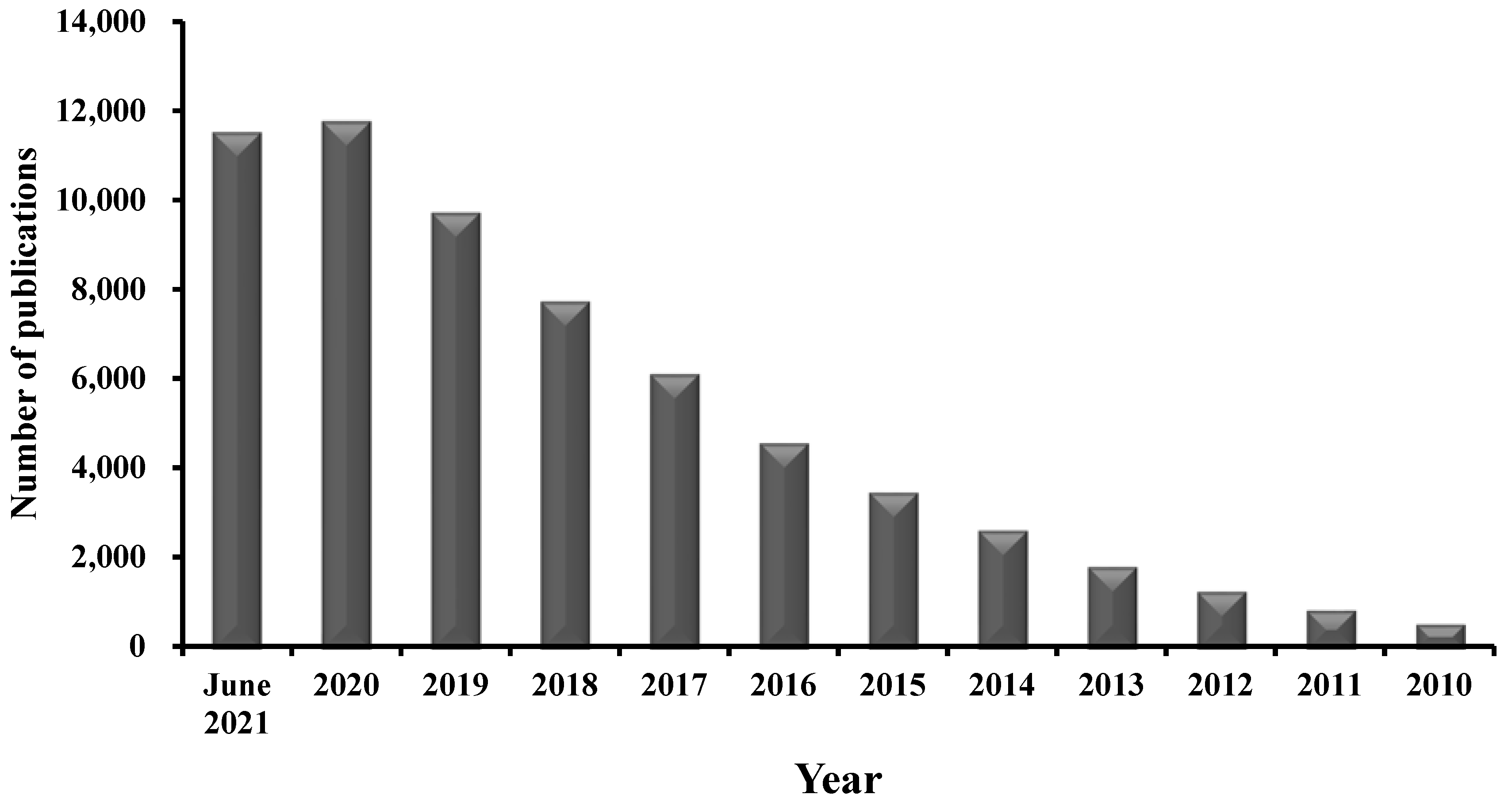

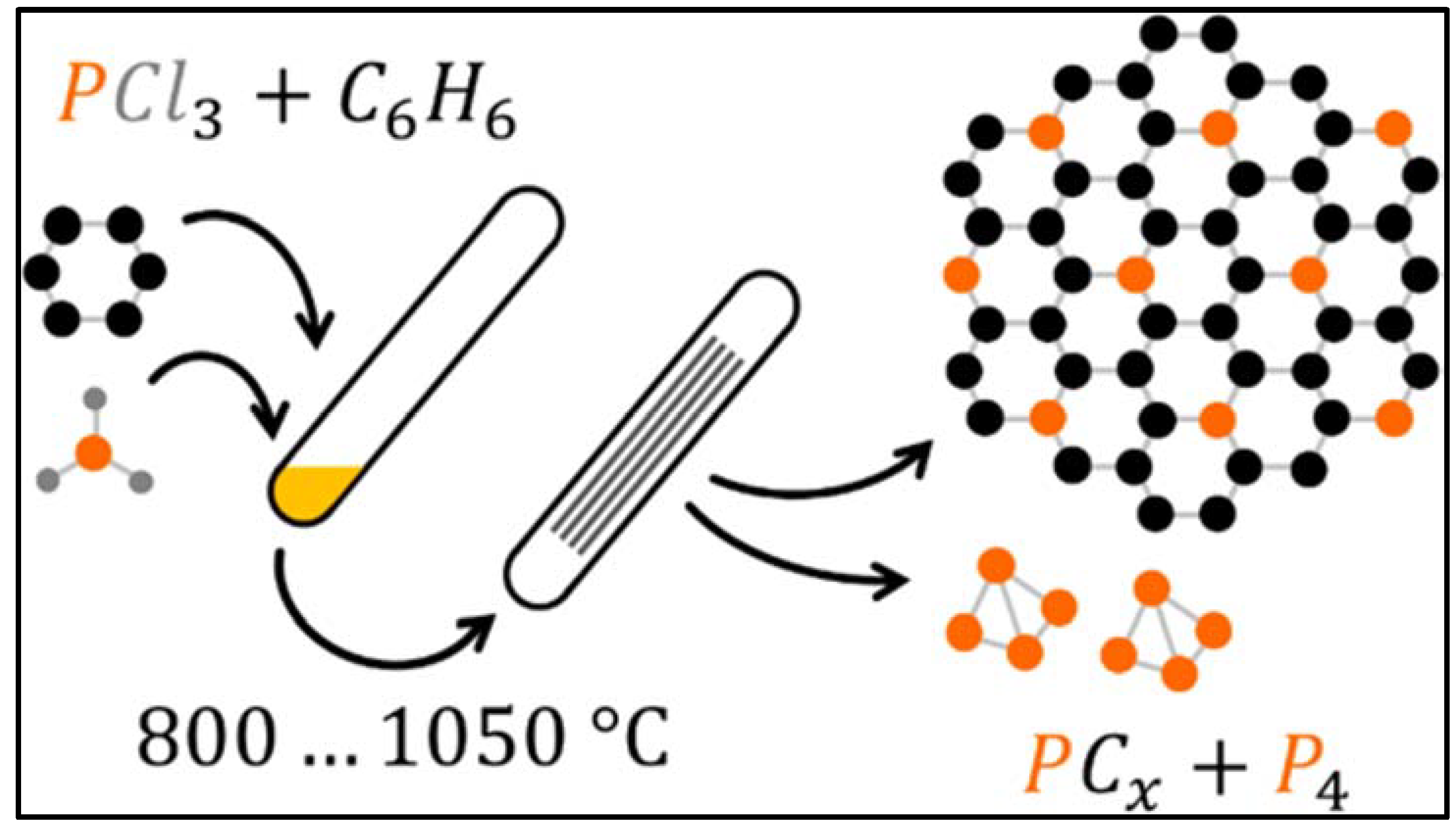

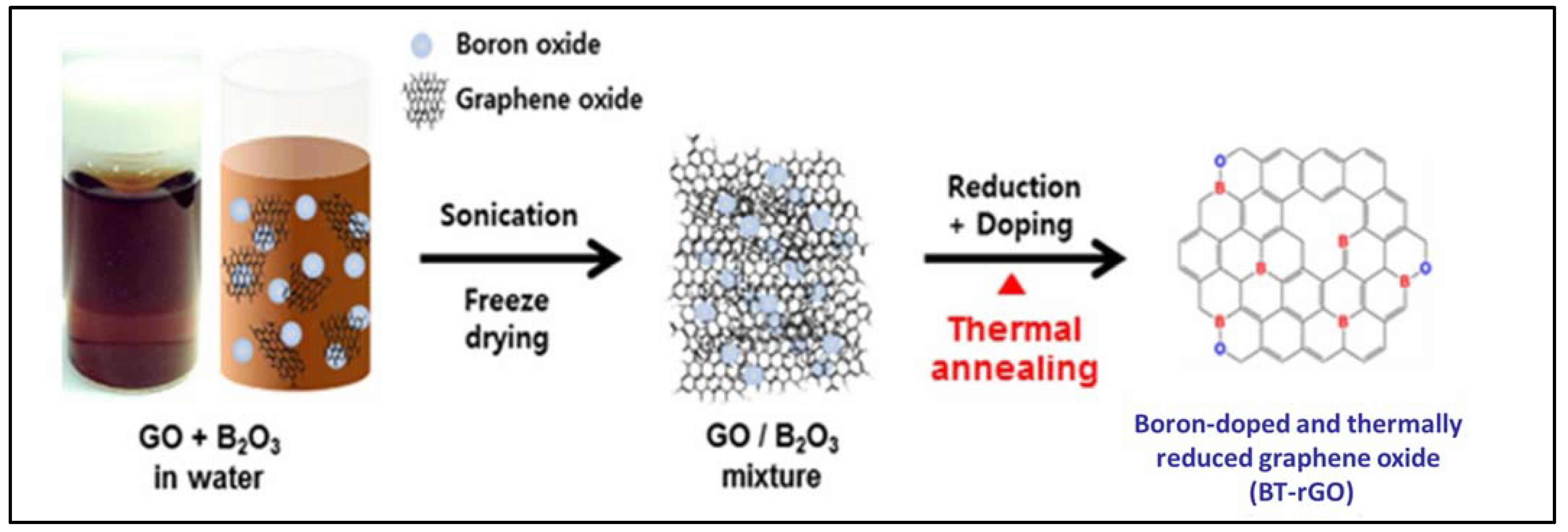
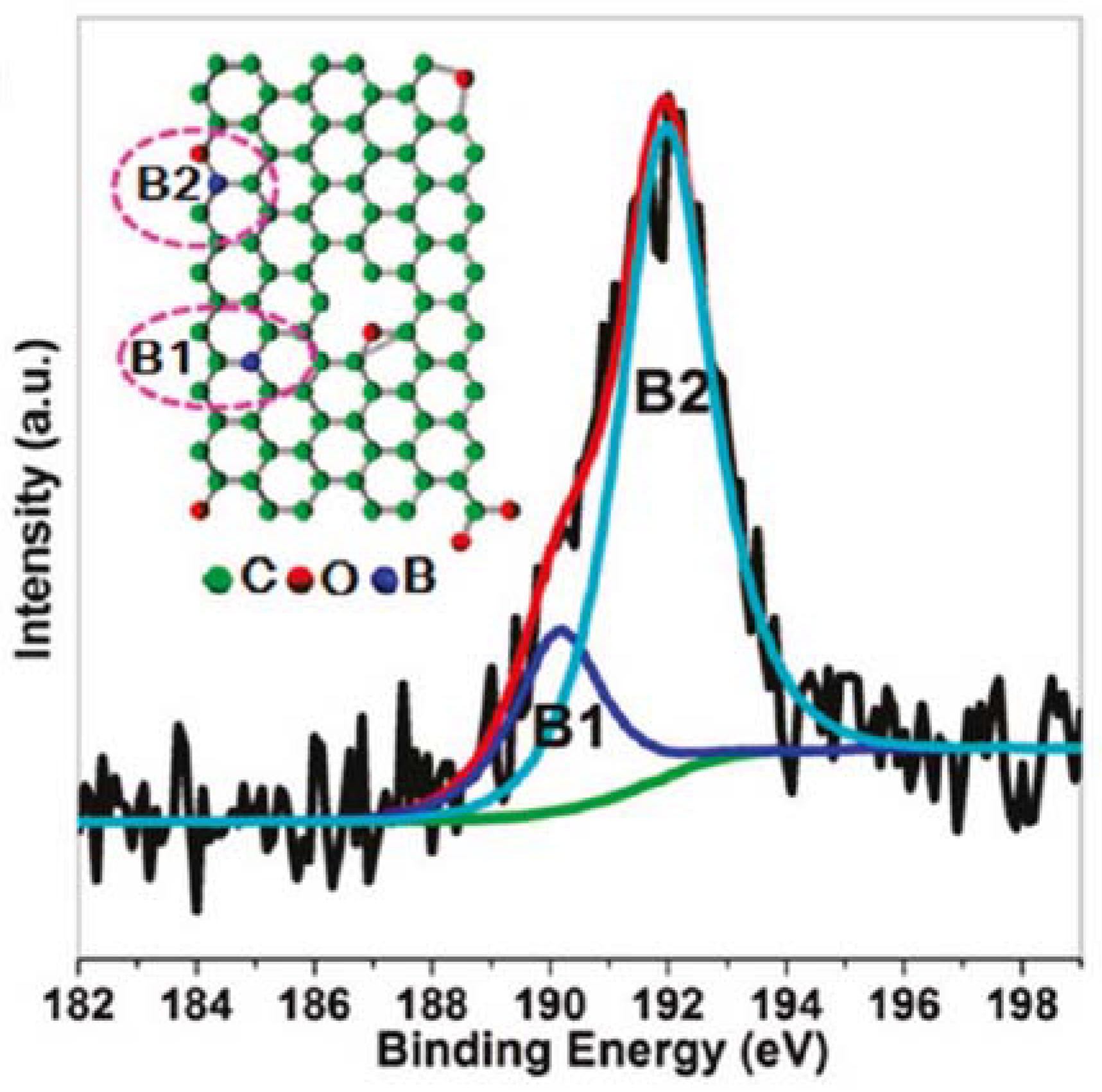

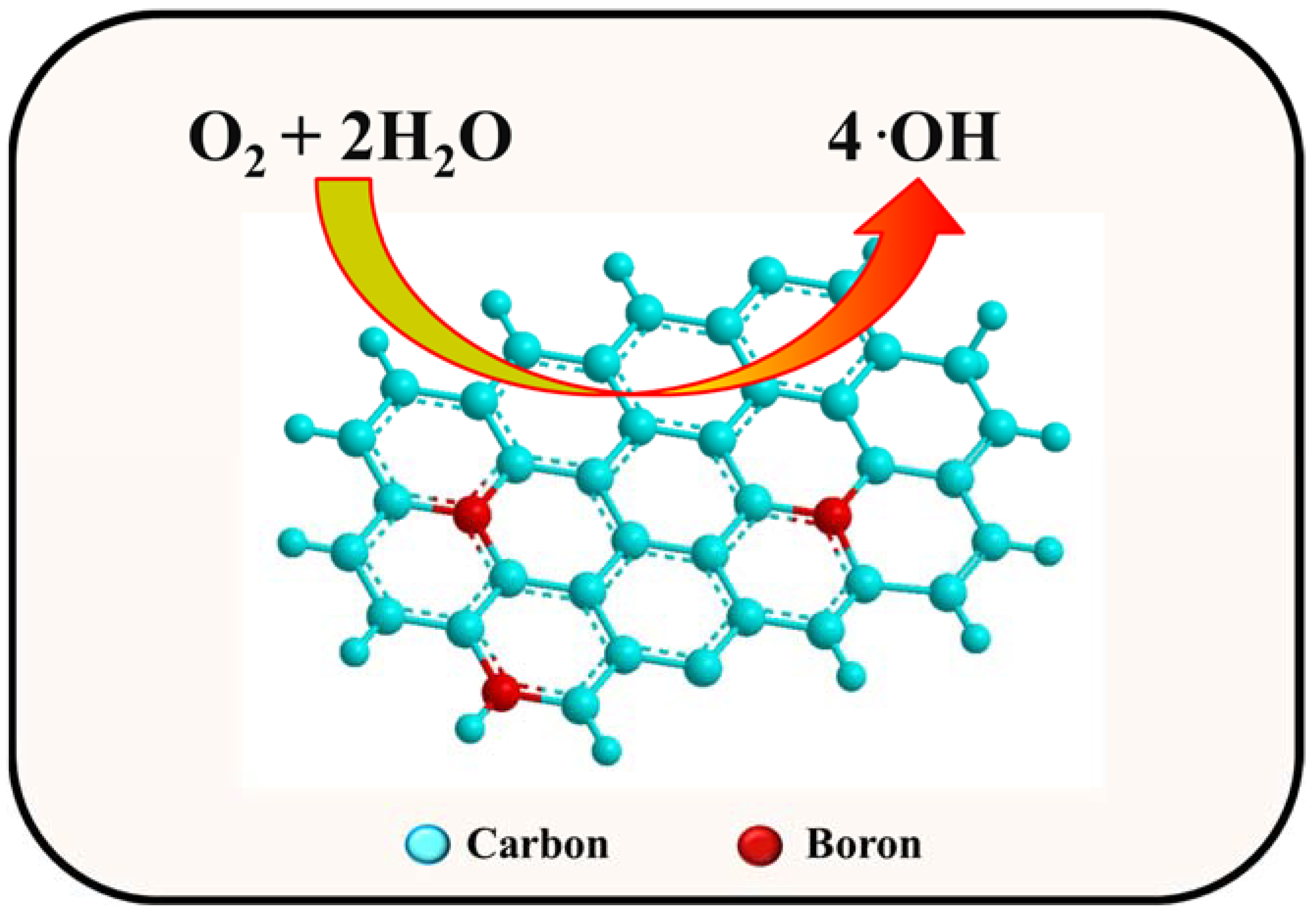
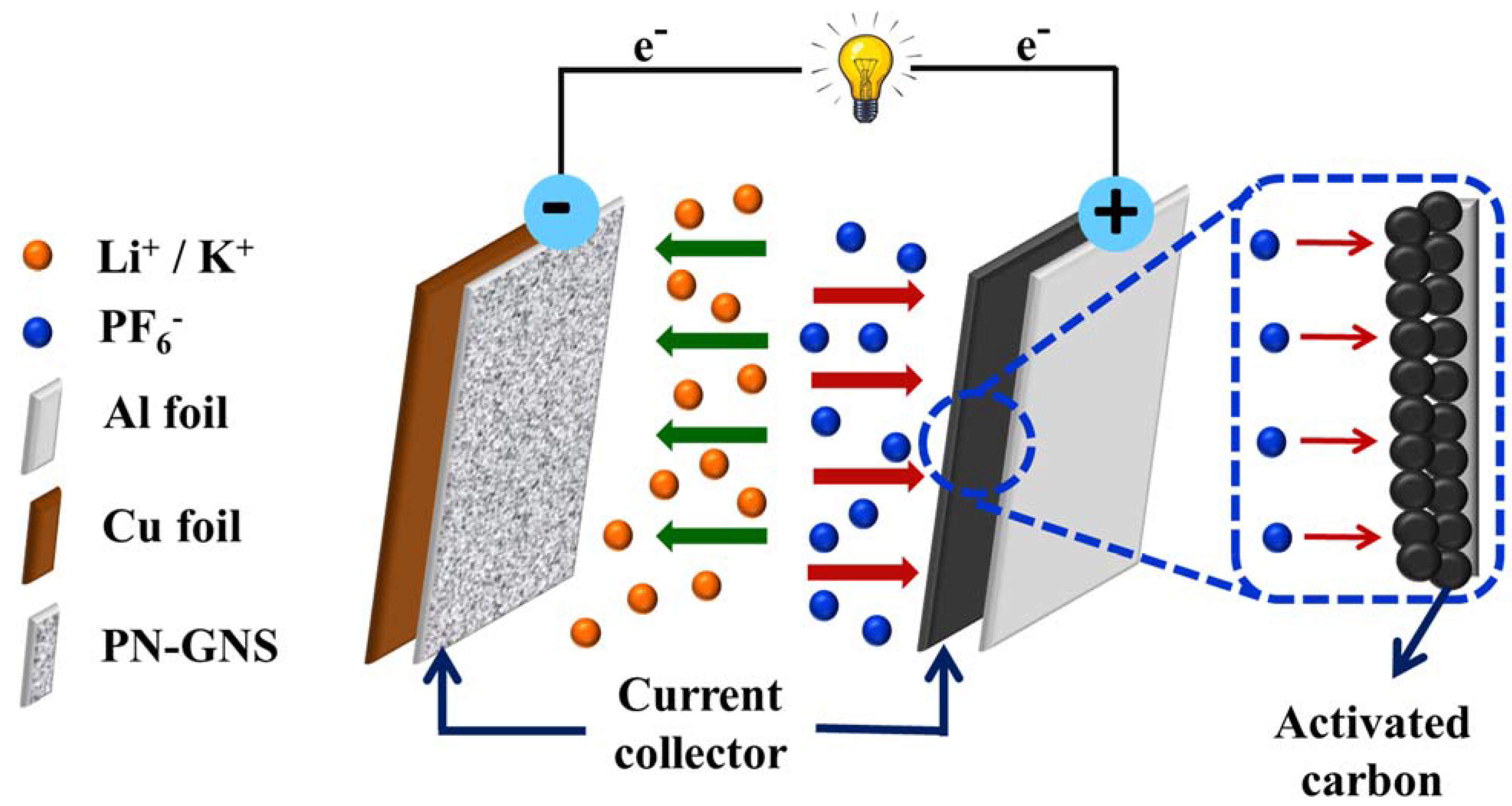

| Synthesis Method | Phosphorous Source | Applications | References |
|---|---|---|---|
| Pyrolysis method | Phosphorous trichloride | - | [74] |
| Thermal annealing | 1-butyl-3-methylimidazolium hexafluorophosphate | Electrocatalyst | [75] |
| Chemical method | Phosphoric acid + Polyphosphoric acid | Flame retardant | [76] |
| Templating method | Phosphorous pentaoxide | - | [77] |
| Thermal annealing | Phosphoric acid | To retard oxidation of rGO | [78] |
| Thermal decomposition | Tri-n-octylphosphine + Tetradecylphosphonic + Tri-n-butylphosphine acid | Supercapacitors | [79] |
| Thermal annealing | Phosphoric acid | Fuel cells | [80] |
| Chemical vapour discharge | triphenylphosphine | - | [81] |
| Electrochemical erosion method | Phosphoric acid | Supercapacitor | [82] |
| Chemical method | Phosphoric acid + Polyphosphoric acid | Supercapacitor | [83] |
| Synthesis Method | Boron Source | Applications | References |
|---|---|---|---|
| Hydrothermal | Orthoboric acid | Photocatalyst | [52] |
| Chemical vapour deposition | Trimethylborate | Supercapacitor | [84] |
| Diborane | - | [85] | |
| Boron powder | Solar cells | [86] | |
| Triethylborane | Gas Sensors | [87] | |
| Phenylboronic acid | - | [88] | |
| Triisopropyl borate | - | [89] | |
| Thermal annealing | Boron oxide | Fuel cells | [90] |
| Self-assembly | Boron oxide | Solar cells | [91] |
| Boron tribromide | - | [92] | |
| Arc-discharge | Boron oxide | - | [93] |
| Thermal annealing | Boron oxide | Supercapacitor | [94] |
| Hydrothermal | Orthoboric acid | Supercapacitor | [95] |
| Solvothermal | Benzene-1,4 diboronic acid | CO2 adsorption | [96] |
| Thermal annealing | Boric acid | NH3 adsorption | [97] |
Disclaimer/Publisher’s Note: The statements, opinions and data contained in all publications are solely those of the individual author(s) and contributor(s) and not of MDPI and/or the editor(s). MDPI and/or the editor(s) disclaim responsibility for any injury to people or property resulting from any ideas, methods, instructions or products referred to in the content. |
© 2023 by the authors. Licensee MDPI, Basel, Switzerland. This article is an open access article distributed under the terms and conditions of the Creative Commons Attribution (CC BY) license (https://creativecommons.org/licenses/by/4.0/).
Share and Cite
Ubhi, M.K.; Kaur, M.; Grewal, J.K.; Sharma, V.K. Phosphorous- and Boron-Doped Graphene-Based Nanomaterials for Energy-Related Applications. Materials 2023, 16, 1155. https://doi.org/10.3390/ma16031155
Ubhi MK, Kaur M, Grewal JK, Sharma VK. Phosphorous- and Boron-Doped Graphene-Based Nanomaterials for Energy-Related Applications. Materials. 2023; 16(3):1155. https://doi.org/10.3390/ma16031155
Chicago/Turabian StyleUbhi, Manpreet Kaur, Manpreet Kaur, Jaspreet Kaur Grewal, and Virender K. Sharma. 2023. "Phosphorous- and Boron-Doped Graphene-Based Nanomaterials for Energy-Related Applications" Materials 16, no. 3: 1155. https://doi.org/10.3390/ma16031155
APA StyleUbhi, M. K., Kaur, M., Grewal, J. K., & Sharma, V. K. (2023). Phosphorous- and Boron-Doped Graphene-Based Nanomaterials for Energy-Related Applications. Materials, 16(3), 1155. https://doi.org/10.3390/ma16031155







